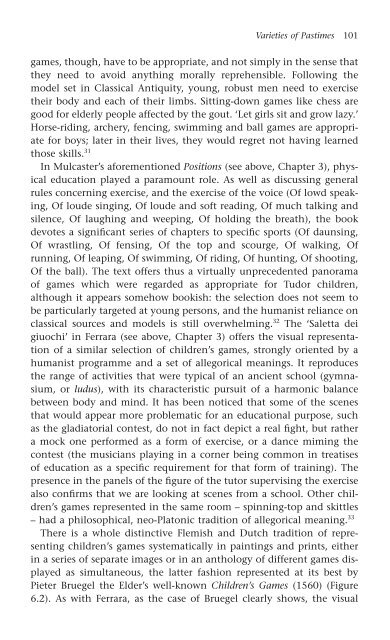Recreation in the Renaissance
Recreation in the Renaissance
Recreation in the Renaissance
- No tags were found...
You also want an ePaper? Increase the reach of your titles
YUMPU automatically turns print PDFs into web optimized ePapers that Google loves.
Varieties of Pastimes 101<br />
games, though, have to be appropriate, and not simply <strong>in</strong> <strong>the</strong> sense that<br />
<strong>the</strong>y need to avoid anyth<strong>in</strong>g morally reprehensible. Follow<strong>in</strong>g <strong>the</strong><br />
model set <strong>in</strong> Classical Antiquity, young, robust men need to exercise<br />
<strong>the</strong>ir body and each of <strong>the</strong>ir limbs. Sitt<strong>in</strong>g-down games like chess are<br />
good for elderly people affected by <strong>the</strong> gout. ‘Let girls sit and grow lazy.’<br />
Horse-rid<strong>in</strong>g, archery, fenc<strong>in</strong>g, swimm<strong>in</strong>g and ball games are appropriate<br />
for boys; later <strong>in</strong> <strong>the</strong>ir lives, <strong>the</strong>y would regret not hav<strong>in</strong>g learned<br />
those skills. 31<br />
In Mulcaster’s aforementioned Positions (see above, Chapter 3), physical<br />
education played a paramount role. As well as discuss<strong>in</strong>g general<br />
rules concern<strong>in</strong>g exercise, and <strong>the</strong> exercise of <strong>the</strong> voice (Of lowd speak<strong>in</strong>g,<br />
Of loude s<strong>in</strong>g<strong>in</strong>g, Of loude and soft read<strong>in</strong>g, Of much talk<strong>in</strong>g and<br />
silence, Of laugh<strong>in</strong>g and weep<strong>in</strong>g, Of hold<strong>in</strong>g <strong>the</strong> breath), <strong>the</strong> book<br />
devotes a significant series of chapters to specific sports (Of dauns<strong>in</strong>g,<br />
Of wrastl<strong>in</strong>g, Of fens<strong>in</strong>g, Of <strong>the</strong> top and scourge, Of walk<strong>in</strong>g, Of<br />
runn<strong>in</strong>g, Of leap<strong>in</strong>g, Of swimm<strong>in</strong>g, Of rid<strong>in</strong>g, Of hunt<strong>in</strong>g, Of shoot<strong>in</strong>g,<br />
Of <strong>the</strong> ball). The text offers thus a virtually unprecedented panorama<br />
of games which were regarded as appropriate for Tudor children,<br />
although it appears somehow bookish: <strong>the</strong> selection does not seem to<br />
be particularly targeted at young persons, and <strong>the</strong> humanist reliance on<br />
classical sources and models is still overwhelm<strong>in</strong>g. 32 The ‘Saletta dei<br />
giuochi’ <strong>in</strong> Ferrara (see above, Chapter 3) offers <strong>the</strong> visual representation<br />
of a similar selection of children’s games, strongly oriented by a<br />
humanist programme and a set of allegorical mean<strong>in</strong>gs. It reproduces<br />
<strong>the</strong> range of activities that were typical of an ancient school (gymnasium,<br />
or ludus), with its characteristic pursuit of a harmonic balance<br />
between body and m<strong>in</strong>d. It has been noticed that some of <strong>the</strong> scenes<br />
that would appear more problematic for an educational purpose, such<br />
as <strong>the</strong> gladiatorial contest, do not <strong>in</strong> fact depict a real fight, but ra<strong>the</strong>r<br />
a mock one performed as a form of exercise, or a dance mim<strong>in</strong>g <strong>the</strong><br />
contest (<strong>the</strong> musicians play<strong>in</strong>g <strong>in</strong> a corner be<strong>in</strong>g common <strong>in</strong> treatises<br />
of education as a specific requirement for that form of tra<strong>in</strong><strong>in</strong>g). The<br />
presence <strong>in</strong> <strong>the</strong> panels of <strong>the</strong> figure of <strong>the</strong> tutor supervis<strong>in</strong>g <strong>the</strong> exercise<br />
also confirms that we are look<strong>in</strong>g at scenes from a school. O<strong>the</strong>r children’s<br />
games represented <strong>in</strong> <strong>the</strong> same room – sp<strong>in</strong>n<strong>in</strong>g-top and skittles<br />
– had a philosophical, neo-Platonic tradition of allegorical mean<strong>in</strong>g. 33<br />
There is a whole dist<strong>in</strong>ctive Flemish and Dutch tradition of represent<strong>in</strong>g<br />
children’s games systematically <strong>in</strong> pa<strong>in</strong>t<strong>in</strong>gs and pr<strong>in</strong>ts, ei<strong>the</strong>r<br />
<strong>in</strong> a series of separate images or <strong>in</strong> an anthology of different games displayed<br />
as simultaneous, <strong>the</strong> latter fashion represented at its best by<br />
Pieter Bruegel <strong>the</strong> Elder’s well-known Children’s Games (1560) (Figure<br />
6.2). As with Ferrara, as <strong>the</strong> case of Bruegel clearly shows, <strong>the</strong> visual










